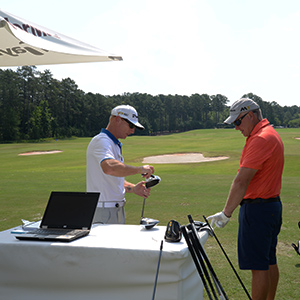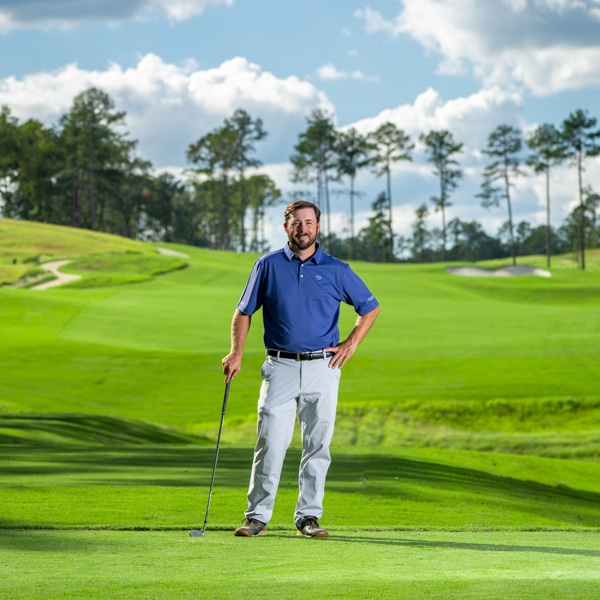BACKGROUNDER —
Leighton Nichols joined the staff of the Reynolds Kingdom of Golf presented by TaylorMade in 2016, matching his unique background as a professional fitness trainer and tour golf professional to the technology of the performance center.
Adept at creating a warm environment in which golfers of all ages can successfully achieve their goals, Nichols has been in the golf industry for four years. A former mini-tour player, Nichols also served as general manager of Perry Country Club in his hometown of Perry, Ga., where he oversaw all daily operations and staff.
Nichols, who earned a degree in marketing from the University of North Carolina, left the golf business to work in marketing for several years. He returned to golf in 2014 as a personal fitness trainer at the Lake Oconee Optimal Performance in Eatonton, Ga., near Reynolds Lake Oconee, with a focus on golf-specific training.
He is certified by the American Council on Exercise, as well as the National Academy of Sports Medicine for golf fitness and corrective exercises.
THE NICHOLS STORY —
As a young kid growing up in Middle Georgia I dreamed of one day becoming a professional baseball player. I started playing baseball at age 4 and it was all I thought about day and night. My grandfather was the warden at a prison close to our home and in those days the prison fielded a softball team to compete in the local recreation department league. On game nights, I always went out on the field and hit once the game was complete and I remember thinking playing under the lights was the greatest thing ever. Well, we all know that life doesn’t go as planned and after some injuries as a teenager I realized that professional baseball was not going to be possible for me.
After realizing my baseball dreams were gone I started playing tournament softball with some of my buddies. When you play in these tournaments you have a long time between games and to kill that time we decided to start playing golf. We would play 9 holes at first but over time we all became addicted to the game. My grandmother played golf when I was young and I always went to junior golf camps during the summer but I never really an interest in playing otherwise. Once I was re-introduced to the game I was hooked and turned all my attention to becoming better.
One of my uncles, Larry Weidel, enjoyed playing golf and was nice enough to help me find some teachers that taught me about the swing. Over time I got to the point where I was playing well and decided to give the mini-tour circuit a shot. During my time playing I learned about club fitting and decided to give it a shot. I couldn’t believe the difference it made and that experience changed the course of my life. The thing I enjoy most about doing club fitting is the smiles I see on peoples’ faces when they see their improvements—the same smile I had that day.

MATT WARD: When you get up in the morning what’s the driving force for you?
LEIGHTON NICHOLS: My main professional goal is to be considered among the best in my field and to help as many people as possible get more enjoyment from this great game.
MW: You deal with all types of golfers in fitting them properly. What’s the most misunderstood element when you first meet before the actual process gets underway?
LN: Just how much we can affect ball flight tendencies with shaft and head combinations. One of the first questions I ask at the beginning of a fit is what that person’s biggest miss is? When I tell them my goal is to eliminate that particular shot you can see them doubt this is possible. Tightening dispersion is always the number one focus and distance increase in secondary.
MW: Clearly, there’s so much information and analysis available today. How do you make sure you give sufficient information and not cause a mental overload?
LN: I think it is important for everyone to understand a few basic data points like launch angle, spin rate, angle of attack and how they affect performance so I take as much time as needed to make sure they do. During that discussion, I can tell if they are interested in the other data being collected.
MW: When students see the info on their golf swings — what’s the common reaction?
LN: That really depends on the person. With Trackman being a part of instruction a lot of people, especially juniors, already know their club speed and launch angles, but just don’t know how to optimize those numbers. On the other hand, I see people who are surprised how fast, or slow, they swing compared to what they thought it was.
MW: Is there a difference in how men and women approach fitting?
LN: No, not really. In general men tend to focus more on maximizing distance and women tend to be more feel orientated.
MW: Best advice you ever received — what was it and who from?
LN: I have been fortunate to receive a lot of good advice from some great people but one thing always sticks in my mind more than others. My grandmother always told me that things happen for a reason and to take things in stride and keep pushing forward. She was a very easy going, calm person and I consider myself the same way.
MW: Is it easier to work with beginners or those more skill level advanced?
LN: The higher level players just hit more consistent shots so they are going to hit less balls during the course of a full fitting than a higher handicap player. Working with both is fun but I can affect changes much easier for the higher handicapper.
MW: What key lessons were learned for those in the golf industry following The Great Recession in ’09?
LN: The industry learned a lot of lessons during that time but to me the main thing was that not enough kids were playing. I think the governing bodies have done a great job since addressing that since that time and I hope they continue to attract a broader audience to the game.
MW: You can change one thing in golf unilaterally – what would it be and why?
LN: It would be great if one day every golf club sold could be fit for that person. The odds of buying a club off the rack and it being optimal for your game are very low. Golf is already hard enough and when you have equipment that doesn’t allow for a good result when you make a decent swing is incredibly frustrating. We need to focus on making golf more enjoyable to continue to grow the game.
MW: When people do get fit — how often should they return to get an updated assessment on their equipment needs — especially as their bodies age?
LN: Every two years is a good rule of thumb for the average person but there are some exceptions to that. Junior players need to be checked every year, especially if they hit a growth spurt. Another example of that would be someone that made swing changes like getting steeper or coming in to impact more shallow.
Click here to view more articles by Matt Ward.Click here to view more articles by Matt Ward.







